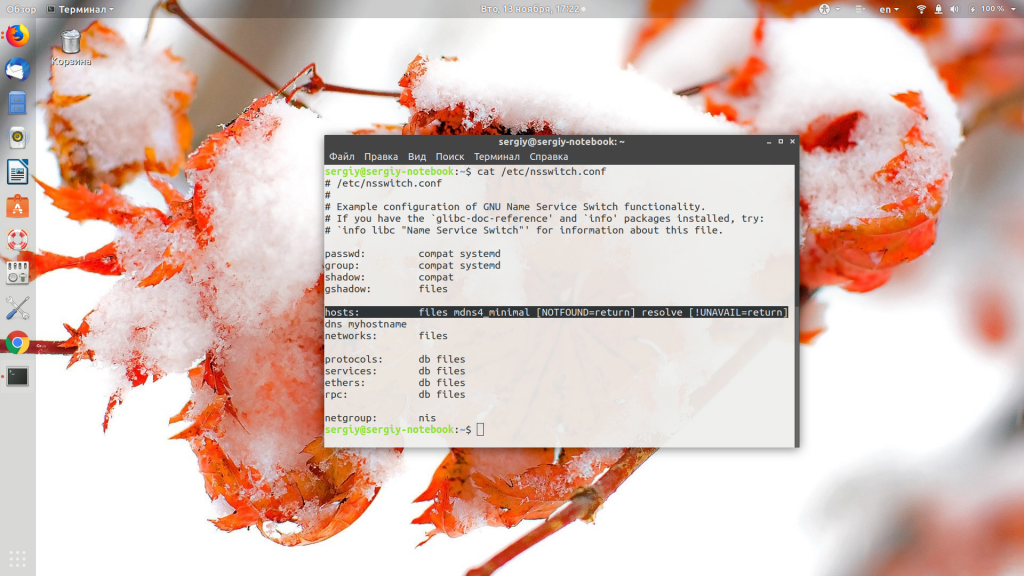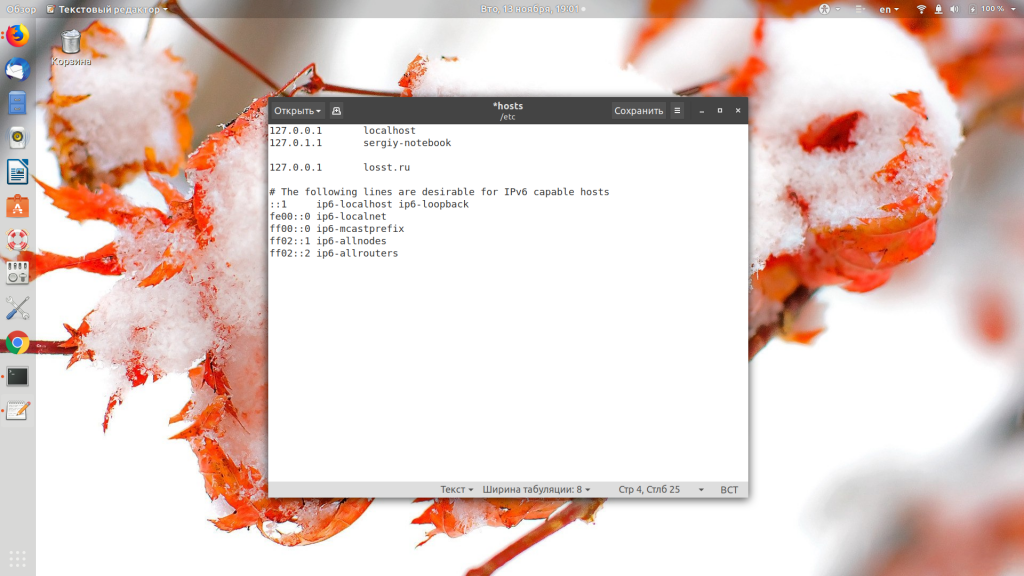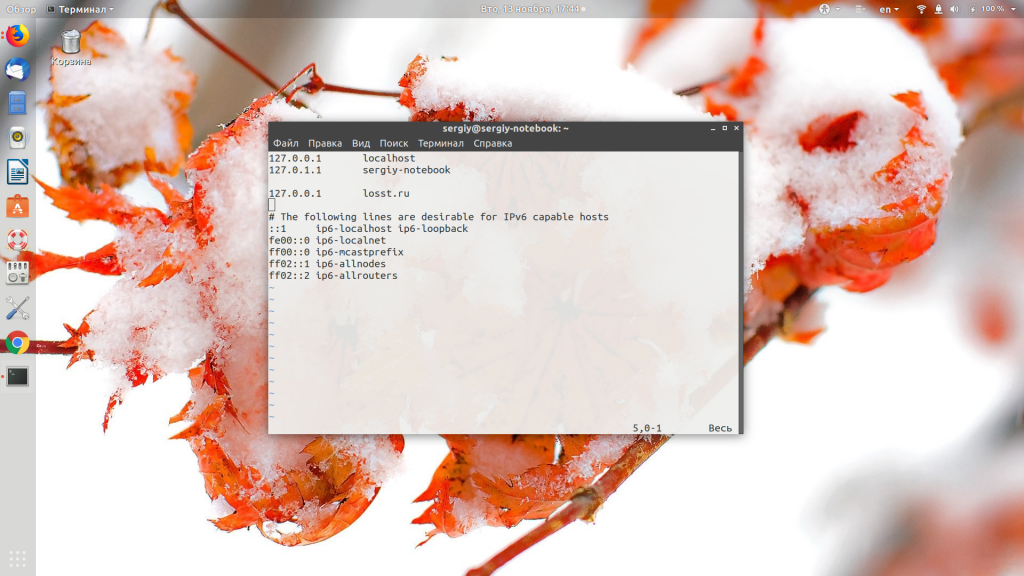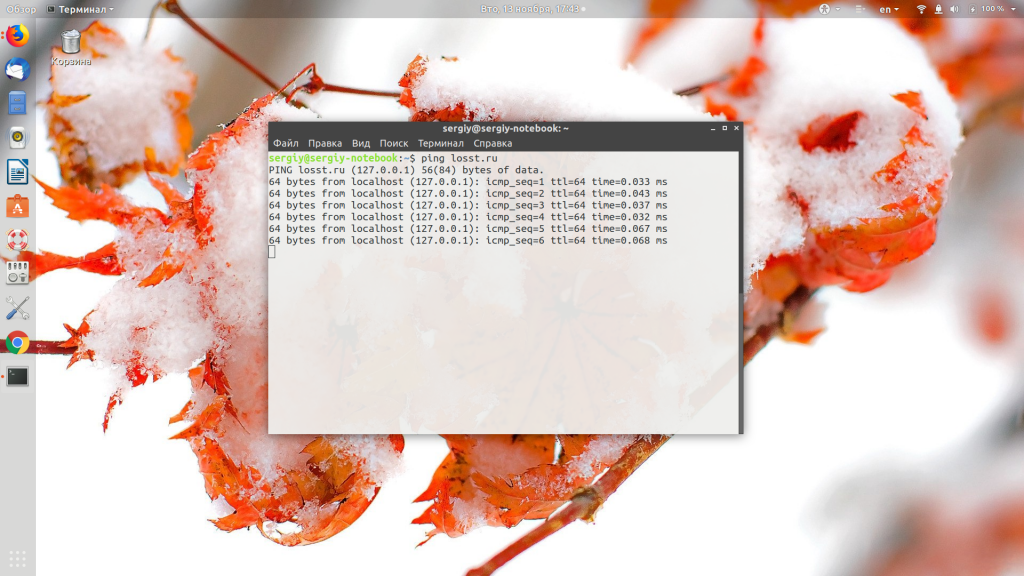Файл hosts в Linux
Система доменных имен DNS используется для определения, какой IP принадлежит к нужному домену в сети интернет. Когда какой-либо программе понадобится обратиться к сайту по его доменному имени, операционная система отправляет к DNS-серверу запрос, чтобы узнать, по какому IP ей дальше передавать пакеты. Но так происходит не всегда. Например, когда мы обращаемся к домену localhost, то всегда запрос отправляется нашему локальному компьютеру.
Всему причиной файл hosts. Если вы раньше пользовались Windows, то, наверное, уже слышали о таком файле. Там чаще всего он использовался для того, чтобы быстро заблокировать доступ к какому-либо ресурсу. Но применение его гораздо шире. В этой статье мы рассмотрим, как настроить файл hosts в Linux, а также какие возможности он нам предоставляет.
Разрешение доменных имён в Linux
Прежде чем мы перейдём к самому файлу hosts, нужно разобраться, как происходит поиск IP-адреса для доменного имени в Linux. Я говорил, что операционная система сразу же отправляет запрос DNS-серверу, но это не совсем так. Существует определённый порядок поиска, согласно которому он выполняется. Этот порядок установлен в конфигурационном файле /etc/nsswitch.conf
Здесь нас интересует строчка hosts. В ней в порядке очередности записаны службы, которые используются для поиска IP-адреса для доменного имени. Пункт files означает использование файла /etc/hosts, а dns — сервиса доменных имён интернета. Если files расположена перед hosts, это означает, что сначала система попытается найти домен в /etc/hosts, а уже потом по DNS. По умолчанию дело обстоит именно так.

Настройка файла hosts в Linux
Нужный нам файл находится в директории /etc/. Для его открытия можно использовать любой текстовый редактор как в командной строке, так и в графическом интерфейсе, только открывать его нужно с правами суперпользователя. Например, с помощью vim:
Синтаксис файла довольно простой. В нём находится несколько строчек с доменными именами и IP-адресами, которые нужно для них использовать. Каждая из них выглядит вот так:
ip_адрес домен алиас
Обычно первая же строчка создаёт правило для перенаправления всех запросов к домену localhost на локальный IP-адрес — 127.0.0.1:
Также в этом файле по умолчанию размещаются перенаправления для имени вашего компьютера и для IPv6-адресов. Вы можете создать свои настройки для любого нужного домена. Для этого нужно добавить строчку в конец файла. Например, направим все запросы к домену losst.pro на ip 127.0.0.1:
Обратите внимание, что здесь указывается только домен, без протокола. Префикс http или https указывать не нужно, иначе ничего работать не будет. А вот для поддомена www нужно создавать отдельную запись или записывать его в виде алиаса. Например:
127.0.0.1 losst.pro www.losst.pro
Теперь при запросе домена losst.pro будет открываться наш локальный IP. Чтобы вернуть доступ к оригинальному ресурсу, достаточно убрать добавленную строчку. Но вы можете использовать не только локальный адрес, но и любой другой. Это очень удобно, если вы только зарегистрировали домен и доменная зона ещё не успела обновиться, а вы уже хотите работать с новым сайтом. Просто добавьте данные в /etc/hosts и работайте как обычно.
Выводы
В этой небольшой статье мы разобрали, как выполняется настройка DNS через файл hosts Linux. Как видите, с его помощью вы можете блокировать доступ к нежелательным ресурсам, например, к которым программы не должны получить доступ, а также использовать его в работе веб-мастера.
Обнаружили ошибку в тексте? Сообщите мне об этом. Выделите текст с ошибкой и нажмите Ctrl+Enter.
The Hosts File on Linux
All operating systems with network support have a hosts file to translate hostnames to IP addresses. Whenever you open a website by typing its hostname, your system will read through the hosts file to check for the corresponding IP and then open it. The hosts file is a simple text file located in the /etc folder on Linux and Mac OS (/etc/hosts). Windows has a hosts file as well, on Windows you can find it in Windows\System32\drivers\etc\
Here is how it looks like:
From what we mentioned, you might expect this file to have a very long list of IPs and corresponding hostnames; but that is not true. The hosts file only contains several lines;
- The first part, by default, contains the hostnames and IP addresses of your localhost and machine. This is the part you will usually modify to make the desired changes.
- The second part has information about IPv6 capable hosts and you will hardly be editing these lines.
Whenever you type an address, your system will check the hosts file for its presence; if it is present, you will be directed to the corresponding IP. If the hostname is not defined in the hosts file, your system will check the DNS server of your internet to look up for the corresponding IP and redirect you accordingly.
Why Edit /etc/hosts file?
By editing the hosts files, you can achieve the following things:
- Block a website
- Handle an attack or resolve a prank
- Create an alias for locations on your local server
- Override addresses that your DNS server provides
- Control access to network traffic
How to Edit /etc/hosts file?
You can edit the hosts text file located at /etc/hosts only as a superuser. You will first have to open it in text editors such as VI editor, Nano editor or gedit, etc. in the Linux terminal. You will then make the required changes and save the file for these changes to take effect.
In this article, we will use the Nano editor to edit the file. Please type the following command:
As mentioned before, we will edit the first part of the hosts file where IP addresses and hostnames are defined. We will explain the following two ways in which you can make use of the hosts file:
Block a Website
You can block a website by redirecting it to the IP of your localhost or the default route.
For example, if we want to block google.com, we can add the following text to our file:
Now when we open the google website, our system will take the IP of our localhost (127.0.0.1) from the hosts file and redirect us to that instead of the google IP from our DNS server.
Now when we open the google website, our system will take the IP of the default route (0.0.0.0) from the hosts file and redirect us to that instead of the google IP from our DNS server.
This is how the edited file will look like. Please save the changes by hitting ctrl+X.
Now when you try to open www.google.com from your browser, you will see an error message as follows:
Please note that we have defined the complete address www.google.com instead of just the hostname google.com in the hosts file because modern browsers sometimes circumvent the block if we only define the latter.
There are also some predefined blocklists available that you may use in your hosts file: https://github.com/StevenBlack/hosts
Access Remote Computer through an Alias
Suppose we have a server located on a local network that we want to access. We usually have to type the server’s IP to access it unless it has been defined on our local DNS. One way to avoid typing the IP, again and again is to assign an alias to the server in the hosts file as follows:
The IP corresponds to the location of the server we want to access, and myserver is the new alias we want to use.
When we save the file and type myserver in the address bar, we will be redirected to our remote server.
We have learned that by making very simple changes to the hosts file, we can customize and thus redirect the network traffic according to our needs. We can also eliminate a network attack or prank by restoring the hosts file to its default.
Etc host file in linux
NAME
hosts - static table lookup for hostnames
SYNOPSIS
DESCRIPTION
This manual page describes the format of the /etc/hosts file. This file is a simple text file that associates IP addresses with hostnames, one line per IP address. For each host a single line should be present with the following information: IP_address canonical_hostname [aliases. ] Fields of the entry are separated by any number of blanks and/or tab characters. Text from a "#" character until the end of the line is a comment, and is ignored. Host names may contain only alphanumeric characters, minus signs ("-"), and periods ("."). They must begin with an alphabetic character and end with an alphanumeric character. Optional aliases provide for name changes, alternate spellings, shorter hostnames, or generic hostnames (for example, localhost). The Berkeley Internet Name Domain (BIND) Server implements the Internet name server for UNIX systems. It augments or replaces the /etc/hosts file or hostname lookup, and frees a host from relying on /etc/hosts being up to date and complete. In modern systems, even though the host table has been superseded by DNS, it is still widely used for: bootstrapping Most systems have a small host table containing the name and address information for important hosts on the local network. This is useful when DNS is not running, for example during system bootup. NIS Sites that use NIS use the host table as input to the NIS host database. Even though NIS can be used with DNS, most NIS sites still use the host table with an entry for all local hosts as a backup. isolated nodes Very small sites that are isolated from the network use the host table instead of DNS. If the local information rarely changes, and the network is not connected to the Internet, DNS offers little advantage. FILES
NOTES
Modifications to this file normally take effect immediately, except in cases where the file is cached by applications. Historical notes RFC 952 gave the original format for the host table, though it has since changed. Before the advent of DNS, the host table was the only way of resolving hostnames on the fledgling Internet. Indeed, this file could be created from the official host data base maintained at the Network Information Control Center (NIC), though local changes were often required to bring it up to date regarding unofficial aliases and/or unknown hosts. The NIC no longer maintains the hosts.txt files, though looking around at the time of writing (circa 2000), there are historical hosts.txt files on the WWW. I just found three, from 92, 94, and 95.
EXAMPLE
127.0.0.1 localhost 192.168.1.10 foo.mydomain.org foo 192.168.1.13 bar.mydomain.org bar 146.82.138.7 master.debian.org master 209.237.226.90 www.opensource.org
SEE ALSO
hostname(1), resolver(3), resolver(5), hostname(7), named(8) Internet RFC 952









